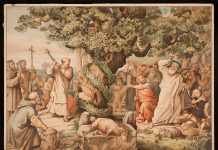Recently, Catholic Insight posted a thoughtful note from Carl Sundell on the essential questions we should be prepared to answer about our faith.
This list of questions was likely meant to inspire readers to find and research their own answers to these questions. There are over 2,000 years of resources one could sift through in order to adequately answer and confidently respond to these questions.
This inspired me to work through these 39 questions in order to provide clear and concise answers for readers. None of these would, or could, be conclusive, but they could help simplify answers and provide a framework for how one can approach these questions.
- How would you explain to a materialist that the soul cannot be material?
Like most of these big questions and answers, much of the important work is done in defining terms. The soul has traditionally been defined as the “principle of life” (For a further exploration of the question “What is Life?” from the philosophical, theological and scientific standpoints, see another Catholic Insight article of mine). While it may be enough for many to accept Aristotle’s definition for the soul, below is a brief way of understanding why the soul can be called the principle of life.
It is important to note that a body is a substance and not an aggregate. A substance is a self-contained thing, where every part in connected and works toward the whole. An aggregate is a collection of related but not necessarily interdependent things. A rock -say of carbon – is a substance. A pile of rocks like in a quarry is not, but rather an aggregate. This is not just because the rocks are not stuck together, but because they are not parts working toward the whole. It is not just a matter of artificial verses natural either. A tree is a substance because every part of the tree works toward the whole. This gets us a little closer to our conversation about the soul and the body because the tree, like a person, is alive.
The thing that brings together all these parts in a substance is the form. The parts of a tree were formed to sustain the tree and the tree as a whole is formed by those parts. The form is the thing that keeps the substance together as the substance it is. Catholics and classical philosophers have called the soul the form of the body because that is what the soul does. We can see the form by the material parts, but the form is not material. We can say that it is a part of being a tree to have branches, but not necessarily those branches on that tree. The form, therefore, must be immaterial, and if the soul is the form then the soul is immaterial.
However, this does not tell us anything about the soul being the principle of life, which will end up being important in the next part of this series anyway. An example that illustrates this point will is the obvious difference between a living body and a dead body. The parts of the body after the person dies no longer work together toward the whole and begin to break apart. This is what decomposition is. The thing that substantiates the body, that unites all the parts together toward the body’s purpose of living, is the principle of life, the soul.
One cannot point to one single organ, brain, heart, lungs, because they all interdependently rely on each other, but there still must be a first cause (not just chronologically first but principally and ontologically first) that upholds the interdependent organs. This shows that the soul not only enlivens the body as a whole and keeps each individual part working together, but that it must be independent of any part in the body. This means that the soul must be independent of the physical body. It must then be non-physical or immaterial.
As a brief aside, even if one cites electricity as a sort of “life-giver” or principle of life, it is still ‘material’, and can be measured in the body. Electricity cannot reliably bring life back to a body (especially if the body has been dead for days, even hours). The only time electricity may help enliven a body is when the body has been “dead” for minutes, during which most people would say the soul has not left the body anyway. Electrical current may be necessary for life, but it is not life.
Without a soul – which is the principle of life – one cannot answer to the existence of minds or consciousness, which are both immaterial realities. Even though Christians, and classical philosophers, would not say the soul is the same as consciousness or the mind, they would both say that these things are related. The mind and consciousness, like the body, still rely upon the soul.
If the soul is immaterial and the body is material, then the question remains of the relationship between the two. The easiest analogy to use would be the genetic code, DNA. Even though the “stuff” of DNA is all physical, the organization or form that the stuff takes would be non-physical, though just as important as the stuff. Without the code, the stuff does not make anything. much less the cells that make up our body. Taken a step further, not only does the code form every individual cell in the body, but also how those cells will form to make every unique but interdependent part of the body (liver cell or heart cell, etc.). You could say that this code formed the body, which is exactly how classical philosophy and the Catholic tradition would describe the relationship between the soul and the body.
The question you should be asking, and probably are, is what about the soul after the body dies? Just because the soul is immaterial does not prove it will continue after the death of the body. The soul of a plant or an animal is also the principle of life, yet their souls do not continue on after death. These questions will be addressed in part five of this series, so stay tuned!
Want to catch up on the previous questions? You can find parts one, two and three here!











